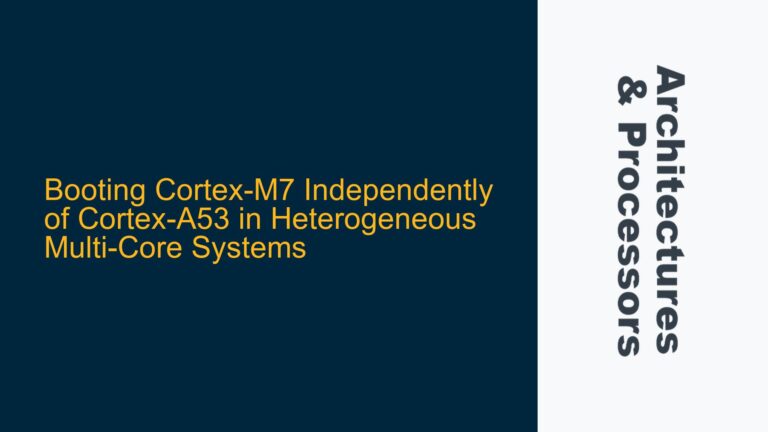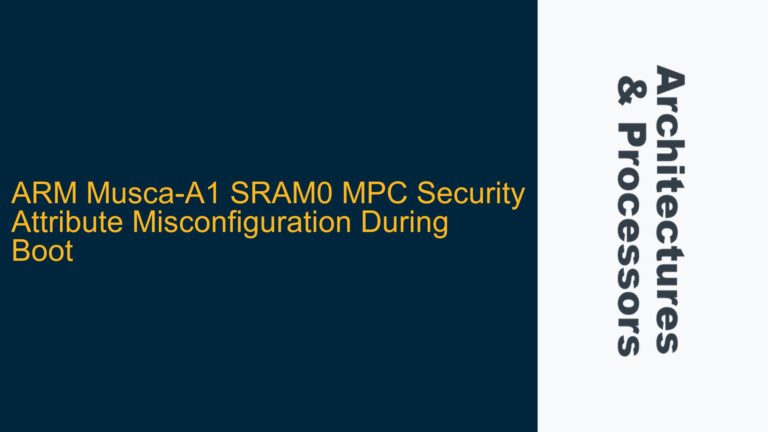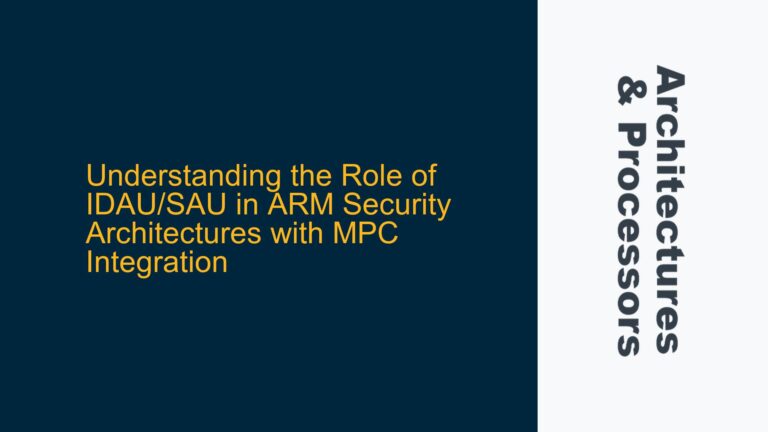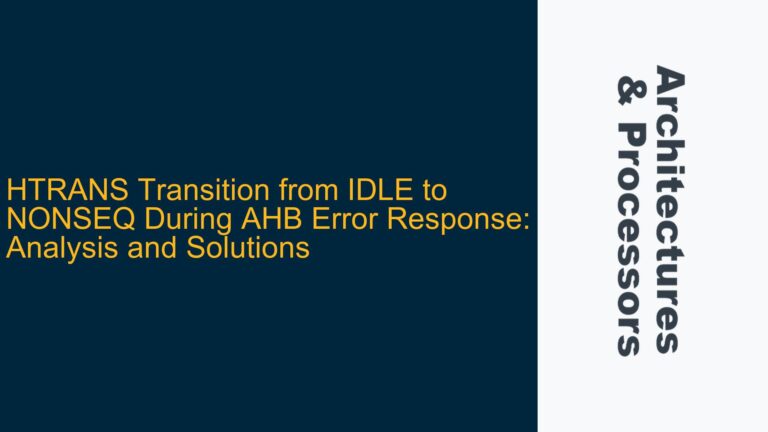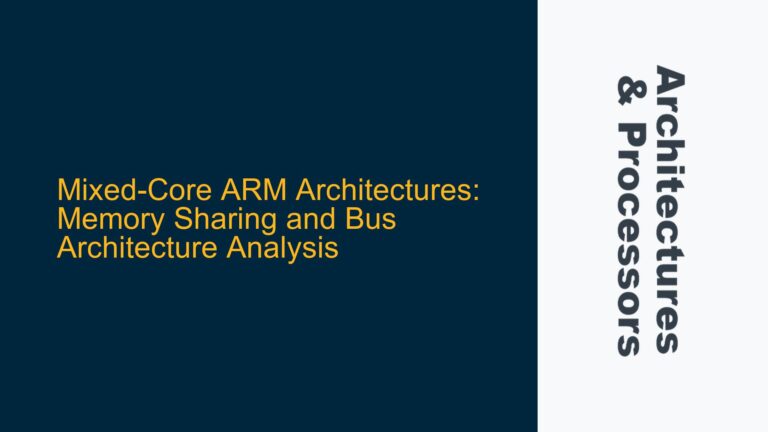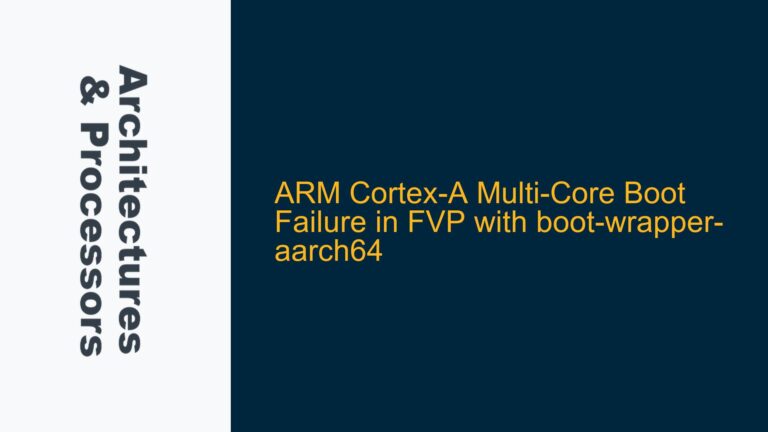ARM Cortex-A8 Fault Handling Mechanisms and Challenges
The ARM Cortex-A8 processor, used in the Beaglebone Black, is a high-performance embedded processor designed for complex applications. Unlike the Cortex-M series, which is optimized for microcontroller applications, the Cortex-A8 is part of the Cortex-A family, targeting applications requiring full-fledged operating systems like Linux. This distinction is crucial when dealing with fault handling, as the mechanisms and strategies differ significantly between the two families.
In the Cortex-A8, fault handling is managed through a combination of hardware and software mechanisms. The processor uses a set of exception vectors to handle various types of faults, such as undefined instructions, data aborts, and prefetch aborts. These exceptions are routed through the ARMv7-A exception model, which defines how the processor transitions from normal execution to exception handling. The exception vectors are typically located at specific memory addresses, and the processor jumps to these addresses when a fault occurs.
One of the primary challenges in implementing fault handling on the Cortex-A8 is the complexity of the exception model. Unlike the Cortex-M series, where fault handling is relatively straightforward due to the simpler exception model, the Cortex-A8 requires a more nuanced approach. The processor operates in different modes (e.g., User, IRQ, FIQ, Abort, Undefined, etc.), each with its own set of registers and privileges. When a fault occurs, the processor switches to the appropriate mode, saves the current state, and jumps to the corresponding exception vector. This complexity necessitates a thorough understanding of the ARMv7-A architecture and the specific behavior of the Cortex-A8.
Another challenge is the interaction between the fault handler and the operating system. In a typical embedded system running an OS like Linux, the OS manages exception handling and provides mechanisms for user-space applications to handle faults. However, in a bare-metal or RTOS environment, the developer must implement the fault handler from scratch. This requires careful consideration of how to save and restore the processor state, how to diagnose the cause of the fault, and how to resume normal operation without causing further issues.
Memory Management Unit (MMU) Misconfiguration and Exception Vector Table Issues
One of the most common causes of faults in ARM Cortex-A8 systems is misconfiguration of the Memory Management Unit (MMU). The MMU is responsible for translating virtual addresses to physical addresses, managing memory protection, and controlling cache behavior. If the MMU is not configured correctly, it can lead to data aborts or prefetch aborts, which are types of faults that occur when the processor attempts to access invalid memory locations.
In the Cortex-A8, the MMU is controlled through a set of registers, including the Translation Table Base Register (TTBR), which points to the base of the translation table. The translation table defines the mapping between virtual and physical addresses and specifies access permissions for different memory regions. If the translation table is not set up correctly, or if the TTBR points to an invalid location, the MMU may generate faults when the processor attempts to access memory.
Another potential cause of faults is issues with the Exception Vector Table (EVT). The EVT is a table of addresses that the processor uses to jump to the appropriate exception handler when a fault occurs. In the Cortex-A8, the EVT is typically located at address 0x00000000 or 0xFFFF0000, depending on the configuration of the Vector Base Address Register (VBAR). If the EVT is not correctly populated with the addresses of the exception handlers, or if the VBAR is not set correctly, the processor may not be able to handle faults properly, leading to system hangs or crashes.
Additionally, the interaction between the MMU and the cache can also cause faults. The Cortex-A8 has separate instruction and data caches, and the MMU controls whether these caches are enabled or disabled for different memory regions. If the cache is enabled for a memory region that is not properly mapped by the MMU, the processor may attempt to access invalid memory locations, leading to faults. Similarly, if the cache is not properly invalidated or cleaned before accessing a memory region, it can lead to data corruption or incorrect behavior.
Implementing and Debugging a Fault Handler for ARM Cortex-A8
Implementing a fault handler for the ARM Cortex-A8 involves several steps, starting with the setup of the Exception Vector Table (EVT). The EVT must be populated with the addresses of the exception handlers for each type of fault. For example, the address of the Data Abort handler should be placed at the offset corresponding to the Data Abort exception in the EVT. The VBAR should be set to the base address of the EVT to ensure that the processor jumps to the correct handler when a fault occurs.
Once the EVT is set up, the next step is to implement the actual fault handlers. Each handler should begin by saving the processor state, including the general-purpose registers, the program counter (PC), and the status registers (CPSR and SPSR). This is necessary to ensure that the processor can resume normal operation after the fault is handled. The handler should then diagnose the cause of the fault by examining the Fault Status Register (FSR) and the Fault Address Register (FAR). These registers provide information about the type of fault and the memory address that caused the fault.
After diagnosing the fault, the handler should take appropriate action to resolve the issue. For example, if the fault was caused by an invalid memory access, the handler might correct the memory mapping or terminate the offending process. If the fault was caused by an undefined instruction, the handler might emulate the instruction or terminate the process. Once the fault is resolved, the handler should restore the processor state and return from the exception using the appropriate instruction (e.g., SUBS PC, LR, #4 for a Data Abort).
Debugging a fault handler can be challenging, especially in a complex system with multiple interacting components. One useful technique is to use a debugger to set breakpoints in the fault handler and examine the processor state when a fault occurs. This can help identify the root cause of the fault and verify that the handler is correctly diagnosing and resolving the issue. Additionally, logging can be used to record information about faults, such as the type of fault, the memory address that caused the fault, and the state of the processor at the time of the fault. This information can be invaluable for diagnosing intermittent or hard-to-reproduce faults.
In some cases, it may be necessary to modify the operating system or the application code to prevent faults from occurring in the first place. For example, if faults are caused by invalid memory accesses, the application code might be modified to perform bounds checking before accessing memory. Similarly, if faults are caused by race conditions or synchronization issues, the operating system might be modified to provide better synchronization primitives.
Finally, it is important to test the fault handler thoroughly to ensure that it can handle all possible types of faults and that it does not introduce new issues. This might involve running stress tests that intentionally generate faults, as well as running normal application code to verify that the fault handler does not interfere with normal operation. By following these steps, it is possible to implement a robust fault handler for the ARM Cortex-A8 that can diagnose and resolve faults, allowing the system to continue operating even in the presence of errors.
Advanced Techniques for Fault Handling and System Recovery
In addition to the basic fault handling mechanisms described above, there are several advanced techniques that can be used to improve the robustness and reliability of an ARM Cortex-A8 system. One such technique is the use of watchpoints and breakpoints to detect and handle faults before they cause serious issues. Watchpoints are hardware mechanisms that can be used to monitor specific memory locations and trigger an exception when a particular access pattern is detected. Breakpoints, on the other hand, are used to halt the processor when a specific instruction is executed. By using watchpoints and breakpoints, it is possible to detect potential faults early and take corrective action before they escalate.
Another advanced technique is the use of memory protection units (MPUs) to enforce access permissions and prevent invalid memory accesses. The Cortex-A8 includes an MPU that can be used to define memory regions with specific access permissions. For example, the MPU can be configured to prevent user-space applications from accessing kernel memory or to prevent write access to read-only memory regions. By using the MPU, it is possible to prevent many types of faults from occurring in the first place.
In systems where fault tolerance is critical, it may be necessary to implement redundant fault handling mechanisms. For example, a system might include multiple fault handlers that are activated in sequence if the primary handler fails to resolve the fault. Alternatively, the system might include a watchdog timer that resets the processor if a fault is not resolved within a certain time period. These techniques can help ensure that the system can recover from faults even in the presence of hardware or software failures.
Finally, it is important to consider the impact of fault handling on system performance. Fault handlers can introduce latency, especially if they involve complex diagnostic or recovery procedures. In real-time systems, this latency can be critical, and it may be necessary to optimize the fault handler to minimize its impact on system performance. This might involve using faster algorithms for diagnosing faults, reducing the amount of state that needs to be saved and restored, or using hardware acceleration to speed up certain operations.
By combining these advanced techniques with the basic fault handling mechanisms described earlier, it is possible to create a robust and reliable fault handling system for the ARM Cortex-A8. This system can detect, diagnose, and resolve faults quickly and efficiently, ensuring that the system can continue operating even in the presence of errors. Whether you are developing a bare-metal application, an RTOS-based system, or a full-fledged operating system, these techniques can help you build a system that is resilient to faults and capable of recovering from errors without requiring a full system reset.
In conclusion, fault handling on the ARM Cortex-A8 is a complex but essential aspect of system design. By understanding the underlying mechanisms, diagnosing the root causes of faults, and implementing robust fault handlers, you can ensure that your system is capable of handling errors gracefully and continuing to operate even in the face of unexpected issues. Whether you are dealing with MMU misconfigurations, exception vector table issues, or more subtle hardware-software interactions, the techniques and strategies outlined in this guide will help you build a system that is both reliable and resilient.

